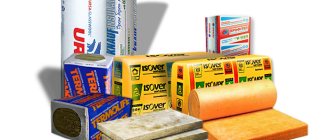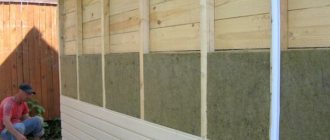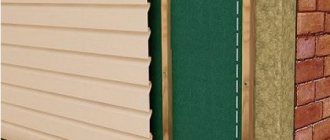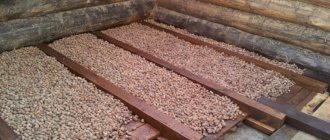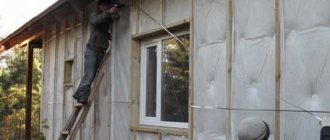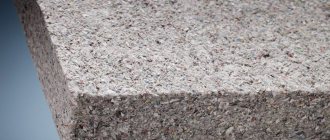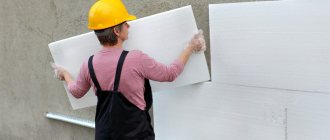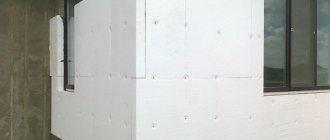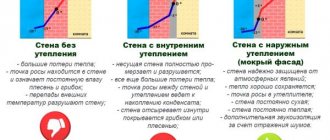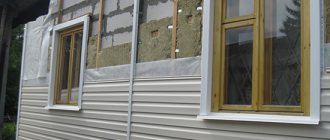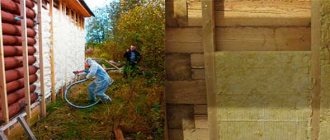Siding has a lot of positive characteristics, but cannot boast of thermal insulation properties. That is why, when finishing residential buildings, the walls are first insulated, and only then the covering panels are attached. Which insulation for siding has the best properties, what criteria should be used to choose it, and how to properly perform insulation with your own hands - this will be discussed in the article.
Insulation for siding
Recommendations for choosing and using insulation for siding
If you decide to use siding for the final exterior decoration of the walls of your house, then you cannot do without installing additional thermal insulation.
A simple air gap between the wall and the siding will not independently cope with the task of retaining heat inside the room; in addition, dampness will inevitably accumulate in this space, which will slowly but surely begin its activity of destroying the walls.
Therefore, apparently, we should not assume that only those houses in which people live throughout the year need insulation.
A good owner will think about a thermal insulation layer even for a country house where the family lives only during the warm season.
What is also important is that thermal insulation is a kind of thermos that will keep the rooms of the house pleasantly cool, even when it is swelteringly hot outside.
Types of insulation for siding for a brick house
- Mineral wool with different densities. Mineral wool, which can be bought in building materials stores, where it is sold in rolls or slabs.
- Glass wool, which is made from fiberglass. Due to its low cost, it is in high demand among owners of private houses.
- Foam plastic, extruded polystyrene foam. This type of insulation is also often used to insulate a brick house.
- Basalt wool (or stone) is made from minerals that melt during the manufacturing process and form a heat-resistant material.
Each of these insulation materials has certain properties, so before purchasing, it is recommended that you familiarize yourself with the physical properties of the insulation and its chemical composition.
Physical indicators include:
- Thermal conductivity coefficient, which has its own value for each insulation;
- Indicator of vapor permeability and moisture resistance;
- Heat resistance indicator.
What insulation materials are suitable for this?
Let's take a closer look at each of the suitable thermal insulation materials. Let's start with the cheapest, that is, glass wool.
Option one. Glass wool
A budget variety of mineral wool, so to speak. The material is quite dangerous, since when working with it, glass dust is released, which is extremely harmful to the respiratory system. When choosing this insulation, be guided by the fact that it will cost several times cheaper than its analogues (more on prices a little later).
Here are the main characteristics of glass wool:
- thermal conductivity index – from 0.029 to 0.041 W/m*K;
- the use of phenol-formaldehyde resin during the joining of fibers, due to which, in fact, toxic substances are released;
- the specific gravity indicator fluctuates between 11 and 25 kilograms per cubic meter;
- high danger to the human body (possible severe irritation of mucous membranes and skin);
- the vapor permeability indicator reaches 0.6 mg/m*h*Pa;
- the material is made from sand, limestone, broken glass, soda and borax;
- glass wool is a non-flammable material;
- high resistance to aggressive chemical environments;
- operating temperature – from minus 60 to plus 250 degrees;
- the fibers of the material do not absorb liquid at all;
- moisture absorption (if glass wool is briefly immersed in water) is approximately 0.8 kilograms per square meter.
From all that has been said above, we can conclude that glass wool would be an ideal insulation material if not for a number of harmful factors; more specifically, he:
- does not burn;
- resistant to high temperatures;
- moisture resistant;
- almost does not allow heat to pass through;
- not afraid of bacteria and fungi.
But health still comes first. That is why in a number of countries glass wool was banned from being used in civil construction. In short, in our case this material is not suitable at all.
Option two. Mineral wool
A common material, including as insulation for siding. It has all the advantages of the previous option, but it does not have its disadvantages. In addition, it is worth noting the long service life of mineral wool, reaching 70 years.
Over the years of operation, this insulation for the walls of a house outside under siding has shown itself only from the best side. You can easily install it yourself, but in the process you must strictly follow all the rules provided for by the installation technology.
In short, if you plan to use mineral wool to insulate walls under siding, you must take care to protect the material from getting wet. This can be achieved with the help of special membranes - moisture, wind and vapor protection (more on this a little later). The heat insulator in this case will be wrapped in a waterproof film. Manufacturers claim that such protection functions like a valve, since it only allows steam to pass out. Steam will not penetrate into the material from inside. What about the “breathing” of the walls, many will ask? The fact is that such “breathing” does not involve the movement of air through the walls; a ventilation system is used to ensure air exchange - even old log houses “breathed” only thanks to the stove draft, and not due to air penetration through the walls.
In short, mineral wool is a good option for thermal insulation of the outside walls of a house under siding. Go ahead.
Option three. Styrofoam
This material is characterized by a fairly low thermal conductivity (no more than 0.043 W/m*K), and therefore is rightfully considered one of the most effective modern thermal insulators. It is used in many areas, including for insulating the outside walls of a house under siding.
And it’s not surprising, because polystyrene foam has many advantages. So, it is quite easy to install, and it does not need waterproofing. It is also easy to work with polystyrene foam - it weighs little, is easy to cut, and does not emit any harmful dust.
Extruded foam plastic has a minimal thermal conductivity, but it:
- very durable;
- resistant to bacteria, fungi;
- not afraid of high humidity.
Its surface after installation will be protected by siding, and therefore the negative impact of the environment will be minimized. Therefore, extruded foam plastic is one of the best options for insulating the outside walls of a house under siding, especially since its modern varieties are safe both from a fire point of view and from an environmental point of view.
Useful tips
We recommend starting work from the rear facade of the building - firstly, possible errors will be less visible here, and secondly, if you get to the front facade, you will already have good practice in installing siding. When the first panel is reliably defined, we proceed to extension.
So, it is quite possible to install siding with insulation yourself, the main thing is to follow the technology and in the process do not forget to once again check the quality of the work - this will save you from the need to redo it in the future.
Korovin Sergey Dmitrievich
Master of Architecture, graduated from Samara State University of Architecture and Civil Engineering. 11 years of experience in design and construction.
Siding is becoming more and more popular every day. Lamellas made from high-quality raw materials are durable and practical. This material replaced wooden panels and, due to its availability, has become a real favorite of the construction market. Unlike natural cladding, it does not require additional protection from external factors.
Probably, many will be interested in knowing how houses are insulated from the outside with siding, and we will try to give a detailed answer to this question. To begin with, I would like to introduce you more closely to the technical characteristics of the material, and they are quite good here.
Choosing insulation for a wooden house
Thermal insulation of timber walls can be carried out using facing bricks, concrete or ceramic stones, and small blocks. The only thing is that between the cladding and the surface of the wooden wall there must remain a designed air gap, which is provided in order to remove excess moisture from the wood.
The following can also be used as heat-insulating materials:
Stone wool is a heat-insulating and sound-insulating material that is made mainly from igneous rock melts. It is a type of mineral wool. Gabbro-basalt rock is the raw material for making material fibers;
Expanded polystyrene is an inexpensive, hygienically and sanitarily safe, lightweight but rigid material. Its insulating properties fully satisfy common requirements, but the possibility of cracks forming due to thermal expansion to which the walls are exposed does not allow us to call it the best solution for insulation;
Ecowool is an absolutely natural, environmentally friendly, ideally soundproofing material made up of cellulose and antiseptics based on borax and boric acid. The material is moisture-resistant, hypoallergenic, and can be installed without creating seams or voids. Does not require the use of a vapor barrier layer when insulating timber walls;
Basalt wool is characterized by excellent vapor permeability. Basalt is a non-flammable material, which provides fire protection for a wooden log house. The material has good noise insulation characteristics;
Foam glass is foamed glass made up of thousands of cells of glass. The material is elastic, moisture-resistant, environmentally friendly, fireproof, very durable and can withstand any temperature fluctuations. It does not attract insects and prevents the formation of mold and mildew. Disadvantages include the lack of steam conductivity, high fragility and high cost of the material;
In the case of wooden walls, mineral wool is ideal as a thermal insulator. It meets almost all the requirements for insulation, namely, it has a high thermal insulation coefficient, a minimum thermal conductivity coefficient and low hygroscopicity. She is not afraid of high temperatures, fungus, mold, insects and rodents
It perfectly copes with the removal of vapors to the outside, is non-toxic, non-flammable, breathable and, importantly, durable and can last from 30 to 60 years, based on the declared characteristics of the material.
The following materials are also suitable for insulation:
- Styrofoam;
- extruded polystyrene foam;
- penoplex;
- penofol;
- penoizol;
- polyurethane foam.
Types of insulation
The range of modern insulation materials is very rich and varied, so the issue of choosing a heat-insulating material according to the technical features of the room, the requirements and budget of the buyer will not be particularly difficult.
Positive and negative sides of mineral wool
The advantages inherent in mineral insulation, regardless of the type and its initial characteristics:
- Ease of installation. Even an inexperienced builder can handle the work of insulating walls under siding. It is enough to have minimal skills.
- Minimal shrinkage. During operation, the material shrinks by a maximum of 1-5%. The type of fiber and density of arrangement determines how much it shrinks.
- Resistance to substances of chemical and biological origin.
- Fire resistance. In case of accidental fires, cotton wool can withstand open fire for some time, usually sufficient to extinguish the fire.
- Low level of hygroscopicity. This parameter applies to basalt and stone wool.
- High level of vapor permeability. Thanks to this advantage, the service life of the product is significantly increased.
- Soundproofing. The use of mineral wool when installing interior partitions relieves owners from loud sounds.
- Environmental friendliness. Manufactured from natural ingredients, it can be used without worrying about human health. This does not apply to fiberglass insulation.
- Long operational period. If installation standards and requirements for the use of the material are observed, mineral wool retains its original qualities for 70-80 years.
Disadvantages inherent exclusively to glass wool and slag wool:
- Fragility. The fragility of fiberglass makes working with this type of insulation difficult. It is for this reason that, according to safety regulations, it is not allowed to work with glass wool without a protective set of clothing.
- Formaldehyde. The resins that make up fiberglass-based mineral wool, when exposed to high temperatures, oxidize turning into phenol.
Glass wool
Evgeniy Filimonov
Ask a Question
The popularity of glass wool has dropped noticeably with the advent of basalt and slag insulation on the market, but it is still used in various fields. In appearance, it is not very different from stone wool, but it is more fragile, so many manufacturers additionally reinforce the material by stitching with steel threads.
The peculiarity of glass wool is that the glass fibers, at the slightest impact, are destroyed and form fine dust, which easily eats into the skin, penetrates the respiratory tract, eyes and causes severe irritation. For this reason, you can work with glass wool only in protective clothing, a respirator and goggles.
Characteristics of blow-in insulation
Ecowool is a new material made from cellulose fibers. It contains a binder - lignin, fire retardants and boric acid as an antiseptic. Ecowool is a loose mass that is applied dry or “wet” method.
Ecowool
Penoizol and polyurethane foam have a cellular structure and are applied to walls in liquid form. They are light in weight, so they exert almost no load on the base, but at the same time cover the entire area with a dense, uniform layer. With this method of insulation there is no need to level the walls and install wind protection, which greatly simplifies installation.
Urea-formaldehyde foam - universal insulation
Insulating a house with foam insulation
Pros:
- absence of cold bridges;
- durability;
- low thermal conductivity;
- speed of installation.
Minuses:
- these materials are more expensive than other insulation materials;
- For application it is necessary to have special expensive equipment and experience working with it.
Thermal insulation with polyurethane foam
| Options | Ecowool | Penoizol |
| Thermal conductivity | from 0.037 to 0.042 W/(m*K) | from 0.031 to 0.041 W/(m*K) |
| Layer density | 28-65 kg/m3 | 5-75 kg/m3 |
| Vapor permeability | 0.3 mg/(mhPa) | 0.21–0.24 mg/(mhPa) |
| Flammability degree | G2 | G1 |
| Working temperature | from -40 to +120 0С | -60 + 80 ᵒС |
Selection of mineral wool
7 best mineral wool manufacturers
When you go to a hardware store, you will see many types of mineral wool with different characteristics. The question arises: what characteristics should a material have that is suitable for insulating a house from the outside?
- Type – stone or basalt wool. Slag wool or glass wool is not the best choice for the walls of a residential building. The reasons are high alkalinity and the content of substances that are harmful to humans (especially slag wool).
- Density – from 80 kg/m3 and more. This is due to the fact that the laid material experiences heavy loads. And so that under their influence the insulation does not wrinkle, does not lose its shape and thermal insulation qualities, it must be dense enough.
- Dimensions - most mineral wool for external wall insulation is sold in the form of slabs with a length and width of 1200 by 600 millimeters. The thickness varies and can range from 50 to 150 millimeters.
- Since insulation is carried out from the outside, the mineral wool must be hydrophobic. By absorbing water, this insulation loses its thermal insulation properties by 50-70%. It is worth considering that high humidity outside and its sudden changes are not at all uncommon. Therefore, the ability not to absorb moisture and condensation is very important for mineral wool. However, this is not enough, therefore, when insulating the walls of a wooden house, take care of high-quality hydro- and vapor barrier.
Types of mineral wool
Separately, it is worth discussing the issue of the thickness of the thermal insulation layer. Wood itself has some insulation qualities, and therefore does not require such a large layer of mineral wool as for construction made of concrete or sand-lime brick. For example, in mid-latitude conditions, for a wooden house with a wall thickness of 15 centimeters, a layer of insulation of 10 centimeters would be optimal. If the walls are even thicker, 20 centimeters, then the required layer of mineral wool will be half as much.
Of course, if you live in a region with a sharply continental climate and severe frosts, then the thickness of the wall insulation should be higher. And if sheets of mineral wool 50 or 100 millimeters thick are not enough for thermal insulation, they need to be laid in two layers.
Calculation of insulation thickness online
The table below shows materials that meet the requirements and are suitable for wall insulation.
| Name | Length and width, mm | Thickness, mm | Density, kg/m3 | Thermal conductivity, W/m*K | Price per 1 m3, rub. |
| Baswool VENT FACADE 80 | 1200 by 600 | 100 | 80 | 0,035 | 3052 |
| TechnoNIKOL Technovent Standard 50 | 1200 by 600 | 72-88 | 0,036 | 3100 | |
| Paroc FAS 3 | 1200 by 600 | 100 | 120 | 0,04 | 3450 |
| ISOVER Facade | 1200 by 600 | 100 | 100 | 0,037 | 6700 |
Advantages of ready-made mixtures
The quality of floor coverings is influenced not only by the material they are made of, but also by the strength of the base. It should be as smooth as possible and withstand all loads without problems, and not change its linear dimensions during temperature fluctuations. Modern self-leveling mixtures fully meet the most stringent consumer requirements.
Self-leveling mixtures have a number of advantages
The advantages of the material include important characteristics.
- Great mechanical strength. This property applies only to cement-based mixtures; gypsum has worse parameters. But each floor covering has its own individual requirements; some are satisfied with the characteristics of gypsum.
- Manufacturability. Working with such materials is much easier than making traditional screeds using semi-dry cement-sand mortars for lighthouses.
- Minimum shrinkage parameters. When hardened, the material almost does not lose its original horizontal characteristics, does not sag, does not swell, or cracks.
- High adhesion values. If you fully follow the manufacturer's recommendations, the likelihood of detachment is almost eliminated. Due to such properties, it is possible to significantly reduce the thickness of the layer, and this is a significant saving in expensive compounds.
To ensure high-quality floor leveling, it is necessary to strictly follow the workflow technology
The only drawback is the relatively high price. But professionals know the secrets to reducing the estimated cost of floor repairs; savings can reach significant amounts.
How to choose?
The parameters of each home are unique and require special attention. Installation work will vary depending on what kind of building it is: a country house among a large, ventilated space or a building among houses of the same type where there is no free movement of air flows.
The correct selection of the necessary materials is one of the difficult issues when doing your own cladding and insulation. The choice largely depends on the building material from which the house is made. For example, for construction from solid wooden beams, mineral wool is preferable, and for brick or cinder block, almost all types of insulation are preferred.
It is also recommended to use mineral wool for a timber frame house. This is due to the fact that it is the most fireproof material for wooden buildings.
As for external walls made of aerated concrete, experts advise insulating them with penoplex.
In turn, professionals in the field of construction and installation have identified a number of qualities that insulation should have.
Based on these standards, it will be much easier to make a choice:
- the most important quality is low thermal conductivity;
- the insulation must be hydrophobic or absorb moisture in minute quantities;
- it must “maintain its shape” (not crumble, slide, flow, or change shape due to temperature);
- Particular attention should be paid to its safety for humans; the material must also be fire-resistant and not emit pungent odors when heated;
- It is unacceptable to contain substances that will promote the growth of bacteria, fungi and mold.
Siding also requires attention. Its choice must be approached wisely, since it is affected by natural phenomena (wind, rain, snow, temperature changes, etc.). Each type of siding has its pros and cons, but among the wide variety, the greatest preference is given to vinyl siding panels. Thanks to its properties, it tolerates “street conditions” well, does not fade in the sun for a long time, and is also a “breathable” and safe material.
If you choose metal panels, then you should think about the level of complexity of their installation. A beginner in this matter cannot cope on his own. As for their characteristics, do not forget about their susceptibility to corrosion. Plus, when it rains slantingly, water drops hit the walls and create a high level of noise.
If you still have doubts about the choice, then real consumers will be the best guide in this matter. The best thing to do is talk to the home owners. From them you can find out what pros and cons they identified during operation.
Wall pie device
A wall pie is a collection of layers of materials that are laid vertically in a certain order.
IMPORTANT! Each layer of the wall pie has its own laying characteristics. If the sequence of layers is disrupted, there is a risk of destruction of the entire structure. The construction of a wall pie for external insulation must correspond to the order of laying materials, starting from the inside of the walls:
The construction of a wall pie for external insulation must correspond to the order of laying materials, starting from the inside of the walls:
- interior decoration;
- internal load-bearing layer (plasterboard, sheathing);
- vapor barrier (required in frame houses);
- load-bearing wall;
- insulation;
- waterproofing (depending on insulation);
- sheathing;
- ventilation gap (depending on the heat insulator);
- finishing.
Wooden wall pie
This scheme for laying materials should be followed if the house is timber, frame or log.
If the wall is brick or aerated concrete, then the wall pie is slightly different:
- interior decoration;
- Brick wall;
- insulation;
- ventilation gap (if mineral wool is used);
- load-bearing layer on the outside or sheathing (if it is necessary to install façade materials);
- finishing (plaster, siding, porcelain stoneware).
"Wet" wall cake
Particular importance should be paid to waterproofing and vapor barrier
Types of insulation
The most popular insulation materials for siding today are:
- mineral wool;
- based on polystyrene foam;
- blow-in insulation (ecowool, penoizol, polyurethane foam).
Mineral wool, according to GOST 52953-2008, is divided into three types - stone, slag and glass wool.
To produce the first type, basalt and silicate rocks, as well as their mixtures, are used; slag wool is made from metallurgical waste, glass wool is made from waste from the glass industry. These insulation materials are very thin fibers compressed into thick sheets, which are produced in the form of rolls and mats of various sizes and densities. Additionally, they can have a foil coating. As a rule, to insulate a house under siding, only stone and glass wool are used, since slag insulation is less water resistant.
Mineral wool insulation with foil layer
An example of using mineral wool for insulation under siding
Expanded polystyrene insulation, polystyrene foam and EPS, are lightweight, dense sheets formed from a large number of air-filled closed cells. Thanks to this structure, these insulation materials practically do not absorb water. They are produced only in the form of slabs, differing in density, size, and degree of flammability.
Insulation based on polystyrene foam
Extruded polystyrene foam is perfect for the Russian climate
Blown-in materials are those that are applied to the base using a special installation under high pressure. After drying, they form a durable, seamless coating with excellent thermal insulation properties.
Blown-in insulation - ecowool
Seamless home insulation
EPS (extruded polystyrene foam)
This material has characteristics similar to polystyrene foam, but in all respects it is much better. EPS is widely used in industrial and private construction; its installation does not require much effort or special skills.
Pros:
- high density and strength of the material;
- almost zero hygroscopicity;
- excellent thermal insulation properties;
- good noise absorption performance;
- long service life;
- relatively light weight.
Minuses:
- the cost of EPS is approximately 20-30% higher than that of polystyrene foam;
- does not allow the walls to “breathe”;
- can be damaged by rodents;
- refers to flammable materials.
Types and characteristics
The term “siding” refers to ordinary panels intended for cladding the facades of buildings and auxiliary home structures. In addition to their decorative purpose, the panels are often part of a multi-layer wall covering, installed for the purpose of waterproofing, reducing noise entering the premises, and improving the operational characteristics of the building.
At first, siding was made of wood; nowadays, the variety of types of such external cladding is quite large.
Natural wood remains extremely popular to this day. Of course, modern wood panels are significantly different from the boards that were used before.
Despite the processing of wood, it remains the most environmentally friendly material for the exterior cladding of buildings. No other type of material can compare with it in terms of thermal insulation properties.
Almost all types of modern cladding have a locking part with grooves, allowing the installation of panels with almost no gaps that require sealing.
Metal cladding of houses is not very popular. It is more often used for finishing public buildings, commercial and social buildings, industrial enterprises, offices and other similar buildings.
Most often, galvanized steel is used to produce such panels. The most expensive types are made from aluminum and zinc. The advantages of metal cladding are its reliability (with high-quality anti-corrosion treatment), ease of installation, non-flammability, mechanical strength (however, if the material is inattentively transported or due to a pinpoint impact, it may well become deformed).
Plastic siding is the most popular. More than half of the sales volume of all facade panels comes from this group. Most often, the base substance in them is polyvinyl chloride (PVC), a polymer characterized by excellent performance properties.
Siding installation is so simple and intuitive that anyone, even an inexperienced builder, can handle it.
The best insulation materials
Those home owners who ignore the issue of insulating the external walls of a building are deeply wrong.
No matter how you try, there will certainly remain voids between the wall and the cladding. They will not add heat to the house, but they will collect dampness and create conditions for the appearance of mold, moss, fungi, and insect nests, the proximity of which can be not only unpleasant, but also dangerous.
Any home should be insulated, even country houses where you live only in the summer. This will ensure the safety of the building and freshness in the house in the heat. After all, thermal insulation protects against heat no worse than against frost.
Tools
Installation of siding on insulation involves the use of the following tools:
- Roulette;
- Hacksaw for metal;
- Circular electric saw;
- Crosscut saw;
- The ruler is foldable;
- Hammer pliers;
- Screwdriver;
- Hammer;
- Metal carpenter's hammer;
- Cutter knife;
- Metal scissors;
- Awl;
- Chalk;
- Rope;
- Pliers;
- Level;
- Crimping pliers;
- Protective glasses.
What thermal insulation materials are recommended for siding?
In order for a house to become not only attractive, but also cozy after finishing it with siding, you need to choose the right insulation. For placement under the facade cladding, mineral wool, polystyrene foam or penoplex and ecowool are used. By studying the characteristics of the materials, you can make the best choice.
Foam plastic - polymer rigid boards are easily and quickly mounted on the wall and provide good thermal insulation. The material is not afraid of moisture and frost. Due to low vapor permeability, which requires installation of ventilation in the house, and flammability, polystyrene foam is not considered the best insulation.
Mineral wool is combined with brick and wooden walls; it allows steam to pass through, does not burn, and thanks to its fibrous structure, it effectively insulates noise. The material is produced in rolls and rigid slabs. It is better to use the second option for finishing the facade.
Mineral wool in a roll is difficult to install on a vertical surface, and over time it slips and leaves some areas without insulation. Basalt wool slabs are stacked on top of each other and secured with plastic dowels with a wide head.
The thickness of the insulation is selected depending on the climatic conditions and the building material:
- for concrete - 15 cm;
- for brick - 10 cm;
- coniferous wooden beam - 10 cm.
Ecowool is produced using a completely different technology than mineral wool. Cellulose is used for its production. The material is protected from rotting, rodents and fire by adding borax and boric acid. Installation of insulation is carried out in a wet state using special equipment. At the same time, ecowool is tightly fixed to the wall and provides protection from frost and noise.
Basic requirements for heat insulators
The domestic building materials market offers a huge selection of insulation materials to suit every taste and wallet size.
Thermal insulation of a house from the outside must effectively solve the assigned problems and therefore it is important that the insulation has the following properties:
- Low thermal conductivity coefficient, in the range of 0.03-0.042 W/m2.
- Insensitive to temperature fluctuations.
- Low hygroscopicity.
- Resistance to biological and chemical influences.
- Fire safety.
- Environmentally friendly.
- Resistance to deformation.
Now it is necessary to say a few words about the required thickness of the heat insulator for external insulation of the house. The choice of one thickness or another is determined by three values: the thermal conductivity coefficient, as well as the material and thickness of the walls of the house. Thermal conductivity was discussed above; next, let’s look at the table of the dependence of the thickness of the insulation on the material and the thickness of the walls of the building.
| Wall material | Thickness of load-bearing walls, mm | Required thickness of heat insulator, mm |
| Concrete | ≥ 230 | from 150 |
| Brick | ≥ 510 | from 100 |
| Wooden beam | 150 | from 100 |
| Log | ≥ 200 | from 50 |
Do not forget that the choice of material for insulating the outside of a building is not limited to just one insulation material. This includes high-quality wind protection, fasteners for fixing the thermal insulator to the wall of the building, and material for creating the sheathing.
External insulation technology using foam plastic
To insulate the walls of a private house from the outside, you can use polystyrene foam. The procedure for foam insulation involves the sequence of work performed:
- preparation of walls (cleaning of debris, sealing cracks, priming);
- applying the necessary markings;
- attach a profile at the bottom of the wall, which will serve as the basis for the even laying of the first row of slabs;
- attach the foam by applying the adhesive solution, starting from the bottom corner. The second row of sheets is fastened in a cross pattern;
- after the glue has completely dried, secure the foam with umbrellas;
- the joints are sealed with polyurethane foam, if large, with pieces of polystyrene foam. After hardening, excess foam is cut off;
- To finish slopes and corners, you should use special corners that are glued to the reinforcing mesh tape.
Laying sheets in a checkerboard pattern
Fastening sheets
Sectional diagram of insulation
Further along the wall, a reinforcing mesh is attached to the layer of glue and leveled with a spatula. After the glue has dried, the surface is primed and covered with finishing plaster or other decorative materials.
CAREFULLY!
It is better not to insulate wooden houses with polystyrene foam, since with breathable wood it is better to use porous insulation that can allow moisture and air vapor to pass through.
In this case, mineral wool is ideal.
Preparing the wall surface
Preparing the wall surface with your own hands for attaching insulation to it is as follows:
- All protruding objects are removed from the wall.
- The surface is leveled. To do this, it should be taken into account that the depth of the depressions and protrusions should not be more than 20 millimeters.
- If required, the wall surface should be treated with a primer and leveled with a plaster solution. The primer should be chosen for external use.
Then the insulation is prepared.
Technology for installing insulation under siding
There is nothing complicated about installing insulation under siding:
- Walls are checked for fungus
- A frame is installed: wooden or metal. A wooden frame is better suited for a wooden house, but the slats and boards must be treated with an antiseptic.
- A counter-lattice must be installed under the slab insulation, which is filled with insulation.
- After this, siding slabs are rigidly attached on top.
As you can see, there is nothing complicated about installing insulation under siding. The main thing is to choose the right material and securely fasten the siding panels itself.
